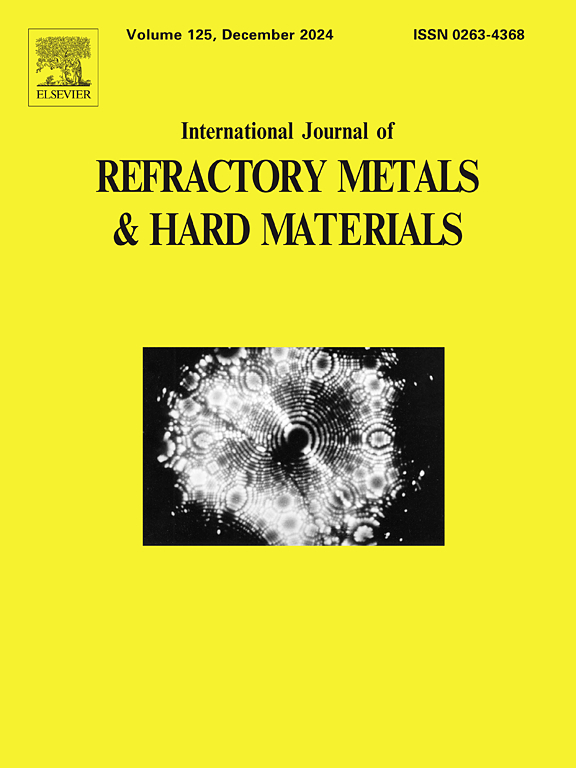Microstructure, fracture behavior and mechanical properties of cellular Ti(C,N)-based cermets with varying Ni contents fabricated by multiphase-flow agglomeration and subsequent vacuum sintering
IF 4.2
2区 材料科学
Q2 MATERIALS SCIENCE, MULTIDISCIPLINARY
International Journal of Refractory Metals & Hard Materials
Pub Date : 2025-03-06
DOI:10.1016/j.ijrmhm.2025.107133
引用次数: 0
Abstract
Cellular Ti(C,N)-based cermets were fabricated using multiphase-flow agglomeration followed by liquid phase sintering. The influence of the Ni binder phase content on the microstructure, mechanical properties and fracture behavior of cermets was investigated. A distinct interface between the matrix and the agglomerates was observed. As the Ni content increased, the volume percentage of the agglomerates dropped and some agglomerates began to dissolve, compromising the integrity of the structure. The TRS of cellular cermets initially elevated before decreasing. Hardness consistently declined, and toughness exhibited the opposite trend. Moreover, the relationship between the volume percentage of agglomerates and the mechanical properties of cellular cermets was modeled mathematically. From cermets A to E, there was a noticeable increase in the proportion of tearing ridges and dimples in both the matrix and agglomerates. Cracks passing through the interface were more likely to bridge or deflect, significantly consuming fracture energy. Furthermore, a larger fractal dimension indicated that the fracture behavior of cellular cermets was highly complex and irregular, contributing to superior fracture toughness. In summary, cellular cermet D containing 22 wt% Ni binder phase exhibited the highest TRS value and better hardness and fracture toughness.
多相流凝聚真空烧结制备不同Ni含量的多孔Ti(C,N)基陶瓷的显微组织、断裂行为和力学性能
采用多相流凝聚-液相烧结法制备了多孔Ti(C,N)基陶瓷。研究了镍结合剂相含量对陶瓷显微组织、力学性能和断裂行为的影响。在基体和团聚体之间观察到明显的界面。随着Ni含量的增加,团聚体的体积百分比下降,部分团聚体开始溶解,影响了结构的完整性。细胞陶瓷的TRS先升高后降低。硬度呈下降趋势,韧性呈相反趋势。此外,还建立了团聚体体积百分比与细胞陶瓷力学性能之间的数学模型。从陶瓷A到E,在基体和团聚体中,撕裂脊和韧窝的比例都明显增加。通过界面的裂缝更容易桥接或偏转,显著消耗断裂能。此外,较大的分形维数表明细胞陶瓷的断裂行为高度复杂和不规则,具有较好的断裂韧性。综上所述,含22wt % Ni粘结剂相的细胞陶瓷D具有最高的TRS值和较好的硬度和断裂韧性。
本文章由计算机程序翻译,如有差异,请以英文原文为准。
求助全文
约1分钟内获得全文
求助全文
来源期刊
CiteScore
7.00
自引率
13.90%
发文量
236
审稿时长
35 days
期刊介绍:
The International Journal of Refractory Metals and Hard Materials (IJRMHM) publishes original research articles concerned with all aspects of refractory metals and hard materials. Refractory metals are defined as metals with melting points higher than 1800 °C. These are tungsten, molybdenum, chromium, tantalum, niobium, hafnium, and rhenium, as well as many compounds and alloys based thereupon. Hard materials that are included in the scope of this journal are defined as materials with hardness values higher than 1000 kg/mm2, primarily intended for applications as manufacturing tools or wear resistant components in mechanical systems. Thus they encompass carbides, nitrides and borides of metals, and related compounds. A special focus of this journal is put on the family of hardmetals, which is also known as cemented tungsten carbide, and cermets which are based on titanium carbide and carbonitrides with or without a metal binder. Ceramics and superhard materials including diamond and cubic boron nitride may also be accepted provided the subject material is presented as hard materials as defined above.

 求助内容:
求助内容: 应助结果提醒方式:
应助结果提醒方式:


